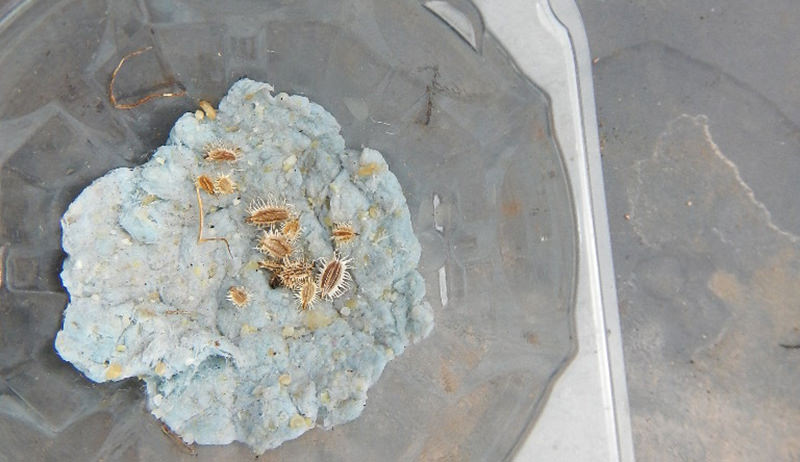
For moms into gardening, seed bombs make a great Mother’s Day gift that kids can make themselves. Making seed bombs is a perfect activity for children because it involves great discussions about growing plants and feeding pollinators. Plus, you make a big, fat mess.
What Are Seed Bombs?

The idea of a seed bomb is to encase hardy seeds, like herbs and wildflowers, inside a biodegradable shell, like paper or clay. Included with the seed is usually some compost or potting soil to help feed the seed as it sprouts. In the 1970s these seed bombs were used by the guerrilla gardening movement and tossed into weed covered lots and abandoned home sites to beautify the area—there’s a little piece of American counterculture you can share with your kids!
Although your child may appreciate a little subversive gardening, you can seed-bomb your own garden and certainly give them as gifts to your favorite gardening friend.
Most seed bomb recipes call for using paper pulp, and that’s the method we’ll cover here. However, should you prefer to use clay and a little creativity, you can learn to make decoratively stamped seed-bomb medallions.
What You’ll Need

- 4 cups loose neutral-colored paper (bills, copies, school work, office memos, junk mail—avoid anything glossy)
- enough water to cover the paper
- natural dye material (see below for ideas)
- potting soil or compost
- seeds (Wildflowers and herbs, like basil and calendula, are good to use, but you can also try vegetables like peas and beets.)
- powdered cinnamon or turmeric*
- a mold—a small candle mold or a cute silicon ice cube tray would work well, though we used a plastic egg carton because that’s what we had on hand
*Joybilee Farm recommends adding a dash of cinnamon and/or turmeric to the inside of your seed bombs to protect against fungus and bacteria damaging your seed once the covering begins to degrade away. I’ve found great success dusting my indoor seed-starting trays with cinnamon so we tried this inside our seed bombs, as well.
Assembling Your Seed Bombs

Rip up your paper and put it in a bowl.
Add your natural dye to the water. Do one vat for each color you want. How much dye you use is dependent on how dark you want your paper, but you shouldn’t need much more than a 1/4 to 1/2 cup of dye tea. See below for a list of good natural dyes you can use, but feel free to experiment.
Pour your dyed water over your paper and allow it to soak for about 30 minutes. If you followed our directions for making paper with your kids, you’ll recognize these first few steps.
Blend each dyed paper vat (water included) in your blender on high. You want your paper to be rough, so only blend for about 20 to 30 seconds.
Pour pulp through a fine mesh sieve, and let it sit to drain for several minutes. Eventually, start kneading out the rest of the water by gently pushing. Have your kids grab handfuls of the pulp to wring out the water. A potato ricer would do this, too, but the manual squishing is more fun.
I suggest going outside for this the rest of the assembly. Place a layer of pulp in the bottom of your mold. Make sure you double check that your kids have really compacted the pulp so that it’s tightly mushed together.
Have each child place a bit of soil and a pinch of cinnamon in the center of the mold. Then they can sprinkle on their seed lightly.
Direct them to cover their work with another layer of pulp and press firmly. Let these seed bombs air dry at least overnight, possibly longer if you live in a humid area. Do not put them in your oven or microwave to dry them faster because you’ll kill the seed inside. You can place a gentle fan near them if you’d like to speed up the drying process.
Once they’re dry, you can wrap up your seed bombs to give them as a gift. Or you can plant them right before a good rain storm.
Other Natural Dye Ideas
Natural dyes are amazing for many projects—even making your own fabric paints! Many plant based dyes are fleeting, meaning they’re not colorfast, which is usually undesirable for any kind of textile dyeing, but for seed-bomb making, you really don’t need to worry about that. There are so many wonderful botanicals that will give you enough color for this project. I’ve provided some ideas below, but feel free to let your kiddos’ imaginations run free if they’d like to try experimenting to find their own.
Most of these botanicals will just need to be covered in water, brought to a boil and simmered for about 10 minutes to produce enough color to use in your dye tea. You won’t need to include any mordants with these dyes because, as I said, we’re not worried about them being colorfast as for fabrics.
Red
- beets
- pomegranate fruit or skins
- rose hips
- hibiscus flowers
Orange
- carrots
- lichen
- onion skins
Yellow
- powdered or fresh turmeric
- sunflower petals
- dandelion flowers
- willow leaves
Green
- spinach
- grass
- Artemisia family of herbs
- yarrow leaves
- peppermint
- chamomile leaves
- red onion skin
- spirulina
Blue/Purple
- Oregon grape berries
- elderberries
- black currants
- blackberries
- purple iris
- violets
Pink
- strawberries
- raspberries
- cherries
- Purple cabbage, violets and blueberry turn your material pink with the addition of a tablespoon or so of fresh lemon juice. If you water down beet juice it will be pink, as well.
Brown
- oregano
- dandelion root
- fennel leaves




